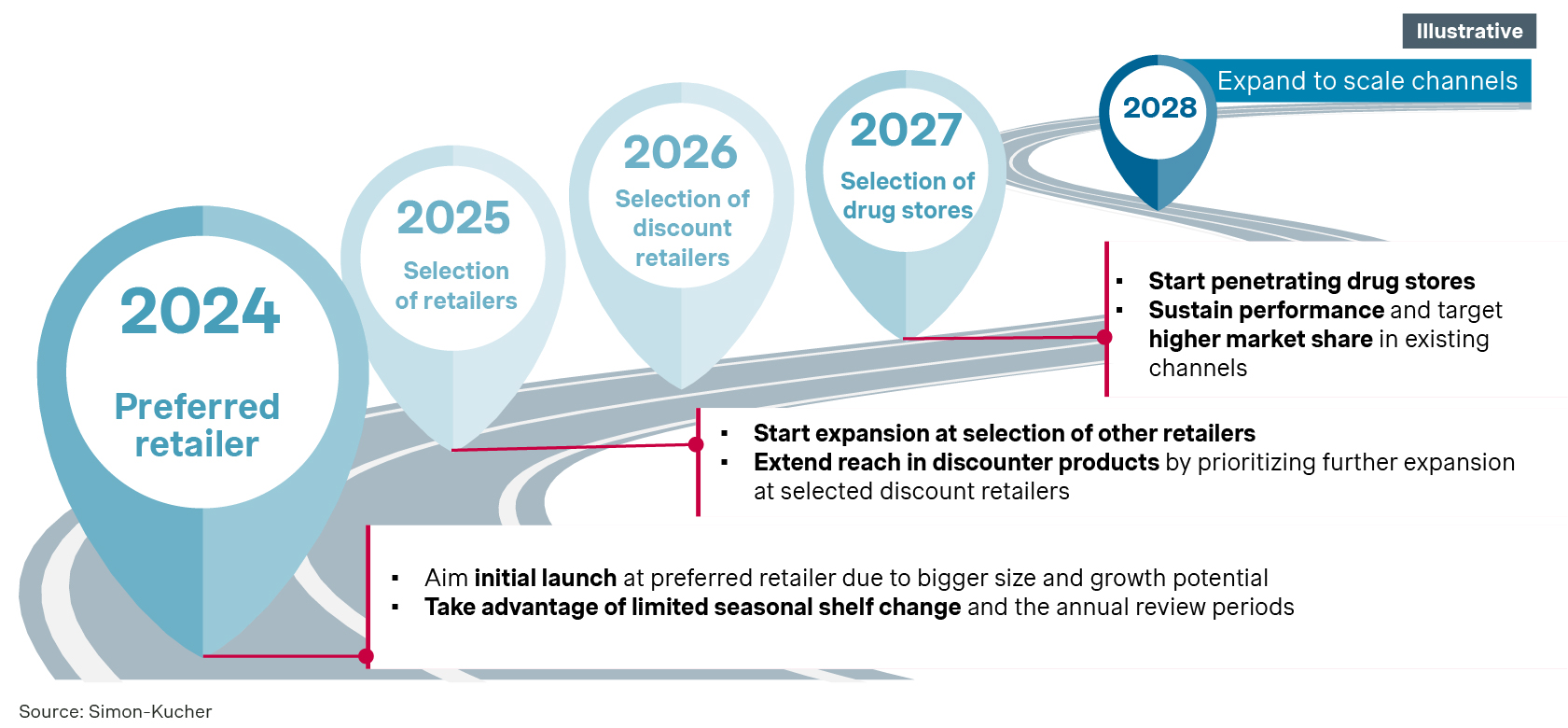Growth is key, especially after the challenges faced in recent years. But how do you best realize growth? Expanding the existing product offering across multiple channels and countries is an efficient way to achieve this. No product development is required and existing materials can be leveraged. Yet, choosing the right channels, partners, product portfolio, and pricing still requires a thought through Go-to-Market strategy.
A Go-to-Market (GtM) strategy addresses these topics by determining how to best enter a market. A GtM strategy is not about whether to enter, but about how to enter a market. With the right GtM strategy in place, business leaders can successfully enter new markets, while avoiding unnecessary complexity by keeping a selective approach to which channels (eg Full service retail, soft discount, hard discount, drug, OOH, DIY, etc.) and channel partners (parties active within a specific channel) to use.
Despite the recognized importance of a well-defined Go-to-Market strategy, many companies fail to properly define theirs. This can be detrimental, as channel cannibalization, misalignment of products with consumer preferences and unnecessary organizational complexity can ultimately lead to a loss of competitive advantage and/or profit.
This article will show business leaders how to set up a successful Go-to-Market strategy, enabling businesses to access new revenue streams while staying efficient and avoiding unnecessary complexity.
Defining a clear Go-to-Market strategy
A Go-to-Market strategy determines the distribution channels for delivering products to the target audience, along with the optimal pack price architecture for each channel. The optimal strategy recognizes that consumers interact with your brand in various ways and aims to create an effective mix of channels to serve them well. However, managing many distribution channels adds complexity. Therefore, in its core, a solid strategy finds the right balance between the added value of certain channels and added complexity to enable the firm to manage their coexistence effectively.
Go-to-Market Framework
Developing and implementing a comprehensive Go-to-Market strategy involves a systematic approach across three key stages: defining the strategy, detailing the strategy, and implementing the strategy. The following paragraphs outline and elaborate on these stages to help successfully establish an optimal GtM strategy.
Stage 1: Defining the strategy
It is imperative that the choice to exploit certain channels is aligned with the overall business strategy. Is the strategic channel objective to grow revenue or to focus on margin? Should the market approach strategy be sales-driven (push) or marketing-driven (pull)? Is the focus of target customers centered around large key accounts or smaller customers? The questions help set the strategic objectives, which are in turn used to create a long list of potential channels.
To derive a set of focus channels from the identified long list of potential channels, we advise to apply two main assessment criteria; attractiveness of the channel and accessibility of the channel. Attractiveness is evaluated based on macro-level criteria, such as segment size, growth, and competitive intensity. Accessibility, on the other hand, consists of access to the value chain of the channel and the ease of customer access through the channel.
In short, the overall business strategy determines the channels under consideration, which are then to be narrowed down based on channel attractiveness and accessibility.

Stage 2: Detailing the strategy
Channels identified as highly attractive and accessible are to be detailed further, by evaluating each partner within these channels. Evaluation takes place on both quantitative and qualitative aspects, such as consumer reach, store coverage, and realizable margin.

Following the prioritized channel partners, one can start defining the offering. Through market research, the optimal packaging size of the product sold per channel-partner is determined, as well as the Recommended Shelf Prices (RSPs).
Stage 3: Implementing the strategy
To ensure smooth implementation, it is key to define the optimal distribution model per channel-partner. Distribution models that could be of interest are, but not limited to, Broker/Distributor model, Direct acquisition model, and Manufacturing partnership model. All options are to be considered based on their respective advantages and disadvantages and whether they are fitting to properly communicate the company values. For instance, would you want high level of brand control, or is access to local retailer data the most important dimension? And is there a financial impact on your choice of distribution model?
Finally, it is key to define a roadmap that pre-empts execution of the channel strategy. The roadmap identifies your chosen partners for the initial launch and outlines future expansion opportunities with other partners or channels. Additionally, KPIs are to be defined to track the performance of all product-channel combinations ensuring the effectiveness of your Go-to-Market strategy. 
Navigating Go-to-Market Complexity
In summary, Go-to-Market strategies are multifaceted and require careful assessment of multiple dimensions to ensure robustness and avoid overly complex channel structures. The growing number of available channels and evolving customer needs add complexity that necessitates a solid GtM strategy. By focusing on developing a well-defined strategy through the three stages, you can secure successful market expansion and realize efficient growth.
The authors wish to thank Joy Machool (Senior Consultant) and David Kraandijk (Consultant) for their contribution to this article.








